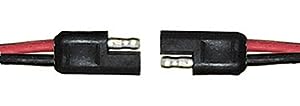wrcsixeight
Well-known member
- Joined
- Sep 14, 2012
- Messages
- 537
- Reaction score
- 0
Your Dometic will likely only pull 3 .5 amps maximum. It all depends on the resistor they added to the thermostat circuit to speed up the compressor for faster cool downs. For long term use the fridge is more efficient at 2000 (minimum) rpm. Higher speeds can suck the heat out of things faster, but requires more electricity to do so.<br><br>It could be anywhere from 2.5 to 5.xx? amps with a Danfoss bd35 compressor.<br><br>Danfoss recommends having the fridge have its own feed wires right to the battery and fused as close to the battery as possible. They don't want is sharing a buss with other devices. They want minimal voltage drop in the wiring from battery to controller. Ciggy plugs are hardly ideal from a connection and resistance point of view. I'd recommend a dedicated quality Ciggy plug receptacle for the fridge, wired with 10awg, and fused right at the battery.<br><br><br><br>Hooking a heavily depleted jumper pack upto a ciggy plug receptacle will melt the fuse every time, because the battery is so hungry for amps it will take everything the wiring can pass initially. Even a 12 amp hour AGM common in jumper packs, when depleted, can ask for 50+ amps briefly. It is hard to charge these properly by paralleling it with the engine battery. the best thing to do when they are super depleted and you cannot plug in, is attach the alligator clips to the engine battery itself with the engine running and let them quench their thirst for a few minutes before trying the double male ciggy plug outlet charge them from inside the van.<br><br>When you get your Van back, run new ciggy plug receptacles to the new house battery, and leave the dashboard ones running on the engine battery, or moves these as well to take power only from the house battery.<br> I try to never deplete my engine battery at all and everything is hooked right to the house batteries, all lighting, all ciggy plugs take from the house.<br><br>If the outlet is truly dead from your dual jumper pack charging attempt, check your main fuse panel, and if those are still good, then the wiring to the plug is compromised somewhere.<br><br>The male ciggy plugs have fuses in the end of them too, if you have the dual male plugs for charging the jumper packs, check for a fuse on each end.







